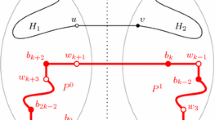Abstract
The balanced hypercube, proposed by Wu and Huang, is a new variation of hypercube. The particular property of the balanced hypercube is that each processor has a backup processor that shares the same neighborhood. A Hamiltonian bipartite graph with bipartition \(V_{0}\cup V_{1}\) is said to be Hamiltonian laceable if there is a Hamiltonian path between any two vertices \(x\in V_{0}\) and \(y\in V_{1}\). A graph \(G\) is hyper-Hamiltonian laceable if it is Hamiltonian laceable and, for any vertex \(v\in V_{i}\), \(i\in \{0,1\}\), there is a Hamiltonian path in G–v between any pair of vertices in \(V_{1-i}\). In this paper, we mainly prove that the balanced hypercube is hyper-Hamiltonian laceable.












Similar content being viewed by others
References
Abraham S, Padmanabhan K (1991) The twisted cube topology for multiprocessors: a study in network asymmetry. J Parallel Distrib Comput 13:104–110
Choudum SA, Sunitha V (2002) Augmented cubes. Networks 40(2):71–84
Cull P, Larson SM (1995) The Möbius cubes. IEEE Trans Comput 44:647–659
Dally WJ (1990) Performance analysis of \(k\)-ary \(n\)-cube interconnection networks. IEEE Trans Comput 39(6):775–785
Efe K (1992) The crossed cube architecture for parallel computation. IEEE Trans Parallel Distrib Syst 3(5):513–524
El-amawy A, Latifi S (1991) Properties and performance of folded hypercubes. IEEE Trans Parallel Distrib Syst 2(1):31–42
Harary F, Lewinter M (1987) Hypercubes and other recursively defined Hamilton laceable graphs. Congr Numer 60:81–84
Hsieh SY, Chen GH, Ho CW (2000) Hamiltonian-laceablity of star graphs. Networks 36:225–232
Hsieh SY, Kuo CN (2007) Hamiltonian-connectivity and strongly Hamiltonian-laceablity of folded hypercubes. Comput Math Appl 53:1040–1044
Hsu W (1993) Fibonacci cubes—a new interconnection topology. IEEE Trans Parallel Distrib Syst 4(1):3–12
Huang K, Wu J (1995) Area efficient layout of balanced hypercubes. Int J High Speed Electron Syst 6(4):631–645
Huang K, Wu J (1997) Fault-tolerant resource placement in balanced hypercubes. Inform Sci 99(3–4):159–172
Jo S, Park J, Chwa K (2013) Paired 2-disjoint path covers and strongly Hamiltonian laceability of bipartite hypercube-like graphs. Inform Sci 242:103–112
Leighton FT (1992) Introduction to parallel algorithms and architectures: arrays, trees, hypercubes. Morgan Kaufmann Publishers, San Mateo, California
Lewinter M, Widulski W (1997) Hyper-Hamilton laceable and caterpillar-spannable product graphs. Comput Math Appl 34(11):99–104
Li TK, Tan JJM, Hsu LH, Sung TY (2001) The shuffle-cubes and their generalization. Inform Process Lett 77:35–41
Lü H, Li X, Zhang H (2012) Matching preclusion for balanced hypercubes. Theor Comput Sci 465: 10–20
Park JH, Kim HC, Lim HS (2006) Many-to-many disjoint path covers in hypercube-like interconnection networks with faulty elements. IEEE Trans Parallel Distrib Syst 17(3):227–240
Preparata FP, Vuillemin J (1981) The cube-connected cycles: a versatile network for parallel computation. Comput Arch Syst 24:300–309
Simmons G (1978) Almost all \(n\)-dimensional rectangular lattices are Hamilton laceable. Congr Numer 21:103–108
Tsai TH, Kung TL, Tan JJM, Hsu LH (2009) On the enhanced hyper-Hamiltonian laceability of hypercubes. In: Proceedings of the 3rd WSEAS International Conference on Computer Engineering and Applications (CEA’09), pp 62–67
Wagh MD, Guzide O (2006) Mapping cycles and trees on wrap-around butterfly graphs. SIAM J Comput 35(3):741–765
West DB (2001) Introduction to graph theory, 2nd edn. Prentice Hall, USA
Wu J, Huang K (1997) The balanced hypercube: a cube-based system for fault-tolerant applications. IEEE Trans Comput 46(4):484–490
Xiang Y, Stewart IA (2011) Augmented \(k\)-ary \(n\)-cubes. Inform Sci 181:239–256
Xu JM (2001) Topological structure and analysis of interconnection networks. Kluwer Academic Publishers, Dordrecht
Xu M, Hu H, Xu J (2007) Edge-pancyclicity and Hamiltonian laceability of the balanced hypercubes. Appl Math Comput 189:1393–1401
Yang M (2010) Bipanconnectivity of balanced hypercubes. Comput Math Appl 60:1859–1867
Yang M (2012) Super connectivity of balanced hypercubes. Appl Math Comput 219:970–975
Acknowledgments
The authors are grateful to the anonymous referees for their comments and constructive suggestions that greatly improved the original manuscript.
Author information
Authors and Affiliations
Corresponding author
Additional information
This research is supported by the National Natural Science Foundation of China (No. 61073046).
Rights and permissions
About this article
Cite this article
Lü, H., Zhang, H. Hyper-Hamiltonian laceability of balanced hypercubes. J Supercomput 68, 302–314 (2014). https://doi.org/10.1007/s11227-013-1040-6
Published:
Issue Date:
DOI: https://doi.org/10.1007/s11227-013-1040-6




